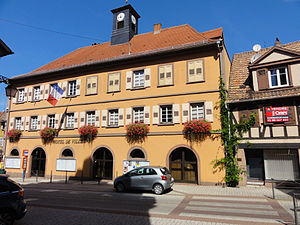Pfaffenhoffen
| Pfaffenhoffen | ||
|---|---|---|

|
|
|
| local community | Val-de-Moder | |
| region | Grand Est | |
| Department | Bas-Rhin | |
| Arrondissement | Haguenau-Wissembourg | |
| Coordinates | 48 ° 51 ' N , 7 ° 37' E | |
| Post Code | 67350 | |
| Former INSEE code | 67372 | |
| Incorporation | January 1, 2016 | |
| status | Commune déléguée | |
 former town hall Pfaffenhoffen |
||

Pfaffenhoffen ( German : Pfaffenhofen , Alsatian : Pfaffhoffe ) is a commune déléguée in the French commune of Val-de-Moder with 2,700 inhabitants (as of January 1, 2017) in the Bas-Rhin department in the Grand Est region (until 2015 Alsace ).
history
middle Ages
Before 1289, the Lords of Lichtenberg bought Pfaffenhofen , initially together with the Lords of Ochsenstein . In 1454 the Ochsenstein part came to Lichtenberg. In 1471 the Lords of Lichtenberg finally bought the last ¼ of Pfaffenhofen, which was still in the possession of some of the citizens of Hagenau . Pfaffenhofen was an imperial fief . In 1335 the land was divided between the middle and younger lines of the House of Lichtenberg . Pfaffenhofen fell to Ludwig III. von Lichtenberg , who founded the younger line of the house. This division of the country was also the occasion for a new internal organization of the Lichtenberg rule: the Ingweiler and Buchsweiler offices of the Lichtenberg rule are reorganized. Among other things, the Pfaffenhofen office was spun off and made independent, to which Pfaffenhofen also belonged as the eponymous location and seat of the official administration.
Anna von Lichtenberg (* 1442; † 1474), one of the two heirlooms of Ludwig V von Lichtenberg (* 1417; † 1474) married Count Philip I the Elder of Hanau-Babenhausen (* 1417; † 1480), one of them had received a small secondary school from the inventory of the County of Hanau in order to be able to get married. The county of Hanau-Lichtenberg came into being through the marriage . After the death of the last Lichtenberger, Jakob von Lichtenberg , an uncle of Anna, Philipp I. d. Ä. 1480 half of the Lichtenberg rule . This half also included the office and municipality of Pfaffenhofen.
Modern times
Count Philip IV of Hanau-Lichtenberg (1514–1590), after taking office in 1538, consistently carried out the Reformation in his county, which now became Lutheran .
As a result of France's reunion policy in 1680, considerable parts of the County of Hanau-Lichtenberg in Alsace fell under the sovereignty of France . This also included Pfaffenhofen.
1736 died with Count Johann Reinhard III. the last male representative of the Hanau family. Due to the marriage of his only daughter, Charlotte (* 1700; † 1726), with the Hereditary Prince Ludwig (VIII.) (* 1691; † 1768) of Hesse-Darmstadt , the county of Hanau-Lichtenberg fell there. In the course of the French Revolution , the left bank of the Hanau-Lichtenberg county - and with it Pfaffenhofen - fell to France.
Pfaffenhoffen has belonged to the Arrondissement Haguenau-Wissembourg since January 1, 2015 , previously to the Arrondissement Saverne .
The municipality of Pfaffenhoffen was merged with the former municipalities of Uberach and La Walck to form the Commune nouvelle Val de Moder with effect from January 1, 2016 .
Population development
| 1798 | 1962 | 1968 | 1975 | 1982 | 1990 | 1999 | 2005 | 2013 |
|---|---|---|---|---|---|---|---|---|
| 1028 | 1802 | 2098 | 2306 | 2261 | 2285 | 2468 | 2677 | 2794 |
Buildings

- Former synagogue from 1791
- The Musée de l'image populaire de Pfaffenhoffen , a museum that mainly presents the Renaissance style of painting
Personalities
- Pantaleon Blasius , Protestant clergyman and reformer, pastor of Pfaffenhoffen
- Gottfried Jakob Schaller (1762–1831), Protestant clergyman and author, was pastor of Pfaffenhoffen from 1785 to 1831.
- Albert Schweitzer (1875–1965), Franco-German doctor, Protestant theologian, organist, philosopher and pacifist. Schweitzer was a citizen of Pfaffenhoffen. The Rue du Docteur Albert Schweitzer , a section of the department road D919, is named after him.
literature
- Fritz Eyer: The territory of the Lords of Lichtenberg 1202-1480. Investigations into the property, the rule and the politics of domestic power of a noble family from the Upper Rhine . In: Writings of the Erwin von Steinbach Foundation . 2nd edition, unchanged in the text, by an introduction extended reprint of the Strasbourg edition, Rhenus-Verlag, 1938. Volume 10 . Pfaehler, Bad Neustadt an der Saale 1985, ISBN 3-922923-31-3 (268 pages).
- Friedrich Knöpp: Territorial holdings of the County of Hanau-Lichtenberg in Hesse-Darmstadt . [typewritten] Darmstadt 1962. [Available in the Hessisches Staatsarchiv Darmstadt , signature: N 282/6].
- Alfred Matt: Bailliages, prévôté et fiefs ayant fait partie de la Seigneurie de Lichtenberg, du Comté de Hanau-Lichtenberg, du Landgraviat de Hesse-Darmstadt . In: Société d'Histoire et d'Archaeologie de Saverne et Environs (Eds.): Cinquième centenaire de la création du Comté de Hanau-Lichtenberg 1480 - 1980 = Pays d'Alsace 111/112 (2, 3/1980), p 7-9.
- Le Patrimoine des Communes du Bas-Rhin . Flohic Editions, Volume 1, Charenton-le-Pont 1999, ISBN 2-84234-055-8 , pp. 227-234.

